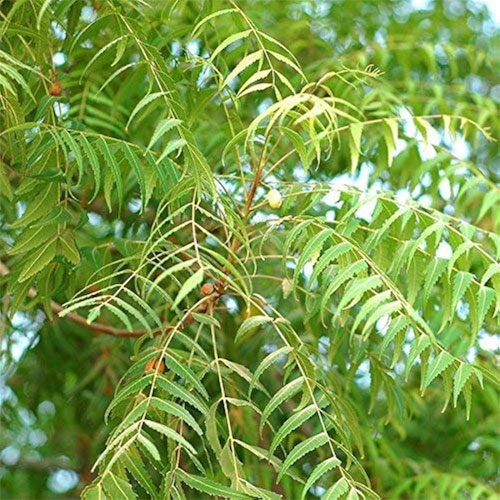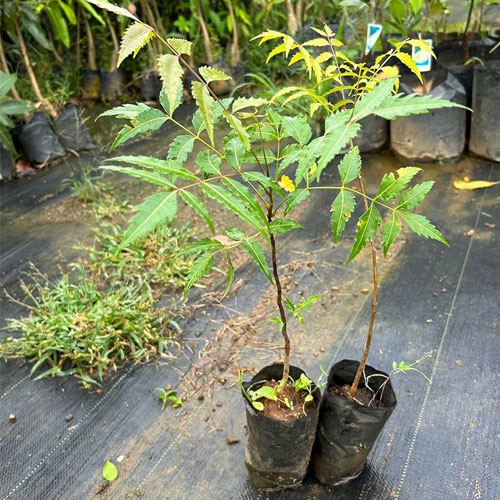The Neem Live Plant (Azadirachta indica) is one of India’s most valued herbal and medicinal trees, known for its wide range of healing properties. Often called the “Village Pharmacy Tree”, Neem is highly regarded in Ayurveda and traditional medicine for its antibacterial, antifungal, and detoxifying qualities. This hardy and fast-growing plant from Golden Hills Farm thrives in all Indian climates, making it a perfect addition to your garden, farm, or herbal corner. It purifies the air, enriches the soil, and provides natural shade — offering both ecological and health benefits in one.
Type of Plant: Herbal / Medicinal Tree – Neem (Azadirachta indica)
Scientific Name: Azadirachta indica
Germination Time: 10 – 15 days (new shoots after planting)
Sunlight Requirements: 6 – 8 hours of full sunlight daily
Where to Grow: Open ground, terrace gardens, or backyard
Growing Season: June – September (monsoon) or February – April (spring)
Soil Requirements: Sandy loam or well-drained fertile soil
Plant Height: 1.5 – 2 feet (at dispatch)
Fertilizer Needs: Apply compost or cow dung every 30–45 days during growth phase
Life Span: Long-lived tree (can survive 150+ years)
Ideal Growing Temperature: 20 °C – 38 °C
Blooming / Harvesting Time: Flowers and leaves available year-round
Maintenance Required: Very low; extremely hardy plant
Watering Frequency: Once or twice per week; drought-tolerant when mature
Ideal Grow Bag Size: 18 × 18 inches or larger


The Neem Plant grows naturally across India in all tropical and subtropical regions. The best planting season is monsoon (June – September), though it can be grown any time in warm climates. It grows rapidly and develops into a tall, spreading tree with lush green leaves and fragrant white flowers. Neem thrives even in poor soils and requires minimal care once established.
Choose a large 18×18 inch grow bag or clay pot with good drainage. Fill it with a mix of garden soil, compost, and sand. Place the plant upright, cover the roots, and water thoroughly. Keep in full sunlight for best growth. As it matures, transplant to open soil for maximum height and spread.
Preparation: Mix sandy loam soil with compost or organic manure.
Planting: Dig a 1×1×1 ft pit, place the Neem plant upright, and refill with soil.
Watering: Water deeply after planting; reduce frequency after establishment.
Germination: Neem establishes easily and grows quickly within weeks.
Transplanting: Shift to open ground after 3–4 months for long-term growth.
Sunlight: Provide full sun (6–8 hours daily).
Soil: Grows in almost any soil type, best in well-drained sandy soil.
Fertilization: Minimal needs; apply organic manure every 2–3 months.
Pruning: Prune lightly to shape young trees.
Pest Control: Naturally pest-resistant — no pesticides required.
Watering: Water sparingly; Neem is drought-tolerant.
Mulching: Add dry leaves or coconut husk to retain soil moisture.
Harvesting: Leaves and twigs can be collected anytime for use.
1. Apply Nutrient-Rich Fertilizers
When your plants begin flowering, use nutrient-rich fertilizers like Organic Bone Meal Powder or Vermicompost. This helps in boosting the bloom and enhances overall yield.
2. Use Organic Fertilizers
Feed your plants with organic fertilizers such as Cow Dung Manure or Neem Cake. Organic options promote healthy soil life.
3. Regular Feeding
Apply fertilizers every 20-25 days to ensure plants receive a steady supply of nutrients. Choose from various options like Cocopeat Compost for moisture retention.
The Neem Live Plant is one of India’s most sacred and beneficial herbal trees. Every part of the plant — leaves, bark, seeds, and flowers — has medicinal value. It acts as a natural air purifier, insect repellent, and soil enricher. Neem leaves are used in Ayurvedic medicines, skincare, and health tonics. The plant is highly drought-resistant, fast-growing, and ideal for organic gardens and eco-friendly landscapes.
Powerful antibacterial, antifungal, and antiviral properties.
Used in Ayurveda for skin, hair, and immune system health.
Acts as a natural pesticide and insect repellent.
Improves soil fertility and purifies surrounding air.
Excellent shade tree for farms and gardens.
Do not overwater; Neem prefers dry conditions.
Ensure good sunlight and airflow.
Protect young saplings from grazing animals.
Avoid waterlogging or heavy clay soils.
Use organic manure only; chemicals are unnecessary.
Problem: Slow growth in shade.
Solution: Move to a full-sun location.
Problem: Leaf yellowing.
Solution: Check for overwatering; Neem thrives in slightly dry soil.
Problem: Stunted growth in poor soil.
Solution: Add compost or organic manure once a month.
Veppu, Nimba, Vepamaram, Margosa Tree, Nim Tree, Azadirachta, Bevu, Bevu Mara, Nemm, Neem Tree India, Herbal Neem.
Q1: Is Neem a medicinal plant?
👉 Yes, every part of the Neem tree has medicinal and Ayurvedic uses.
Q2: Can Neem grow in pots?
👉 Yes, it can grow in pots initially but should be transplanted to soil later.
Q3: How tall does Neem grow?
👉 It can reach 10–15 meters or more when planted in open ground.
Q4: How often should I water Neem?
👉 Water only once or twice a week; avoid overwatering.
Sign in now to receive a 5% instant discount on your first order when using code WELCOME. Begin your organic journey today!
By logging in, you're agreeing to our Terms of Service and Privacy Policy.
Kavya Iyer
Bahut accha experience tha, fast delivery aur genuine plant quality.
Sneha Patel
Neem Live Plant – Herbal Medicinal Tree ke leaves bilkul fresh aur bright green the.
Keerthi Mohan
Bahut fast delivery hui aur Neem plant damage-free tha.
Priya Verma
Bahut accha plant mila, herbal medicinal use ke liye perfect hai.
Deepika Singh
Neem Live Plant fast growing hai aur daily watering me achha grow kar raha hai.
Kiran Babu
Neem Live Plant medicinal use ke liye kaafi effective hai.
Rahul Nanda
Neem Live Plant 100% live condition me deliver hua aur healthy tha.
Sujith R
Received a healthy Neem Live Plant, roots intact and no damage.
Nisha Raj
Plant ka stem strong tha aur roots moist the, koi damage nahi tha.
Rohit Sharma
Received a healthy Neem Live Plant, roots intact and no damage.